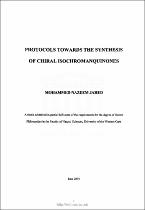| dc.contributor.advisor | Green, Ivan R | |
| dc.contributor.author | Jahed, Mohammed Nazeem | |
| dc.date.accessioned | 2023-06-13T08:47:25Z | |
| dc.date.available | 2023-06-13T08:47:25Z | |
| dc.date.issued | 2001 | |
| dc.identifier.uri | http://hdl.handle.net/11394/10199 | |
| dc.description | Philosophiae Doctor - PhD | en_US |
| dc.description.abstract | Very few protocols have been developed for the synthesis of chiral isochromanols. In recent years the active group of Giles et al. have
developed a very successful and highly efficient protocol using (^9)-ethyl lactate as chiral building block which fixes results chirality at C-3 of the pyran ring. Following a most efficient separation of diastereoisomers at the enantiomeric C-l centre and a highly stereospecific ring closure at the aryl ring the Giles' group were able to after oxidation synthesize both chirally pure 4-hydroxy-isochromanquinones as well as the chirally pure quinones A and A' after Diels Alder cycloadditions with appropriate dienes.
In the present approach a dialkoxylated ortho alkenyl acetyl benzene was reduced to the chiral @)-l'-hydroryethyl anlogue and the enantiomeric excesses were determined and varied from 64 - 80 % depending on the substituents. The notion was that the chiral centre, now at the C-l equivalent position of the pyran ring, would induce preferred chirality at C-3 during the cyclisation of the dialkorylated ortho alkenyl hydroryethyl benzene. Initial attempts at chiral reduction for the non-conjugated prop-2'-enyl isomer lead to a 7 o/oyield of the chiral alcohol together with a large array of other products which were identified. Similar reduction on the conjugated prop-l'-enyl isomer proved
to be much more successful but in this case a dimeric product was always produced which was identified. Mercury@) mediated ring closure under an atmosphere of nitrogen afforded in the main two chiral isochromanes and a benzofuran which could not be effectively separated at
this stage. Chemically pure samples where possible were isolated and fully characterized.
Debenzylation of the 3-benzylory analogues of the isochromanes afforded the corresponding phenols which were then oxidized to the quinones and these were separated on the chromatotron to afford pure samples of two isochromanquinones as well as a benzofuranquinone. The enantiomeric excesses of the isochromanquinones were measured between 48 - 69 %. Finally the mercury(tr) mediated synthesis of 4-hydroxyisochromanes was applied to our precursors in order to obtain chiral 4-hydroryisochromanquinones in the hope that these would have higher biological activity compared to the non-hydrorylated analogues. It was found that the method had to be modified somewhat before hydrorylation took place. At the outset of this method of cyclisation followed by hydrorylation under an atmosphere of oxygen, it was unknown to what extent induced chirality atC4 would occur. In this way we were able to isolate (Rx.9xR>5-benzyloxy-6-methoxy-1,3-dimethyl isochroman4-ol in chirally pure form which was fully characterized and from the chiral shift reagent @uropium tris[3-heptafluoropropylhydromethorymethylene (+) camphoratel) it appeared that the molecuie was chirally pure. Debenzylation followed by Fremy salt oxidation lead to the isolation and characterization of (R)(^9XRlahydory- 6-methory-1,3-dimethylisochromanquinone which also, from comparative spectra containing europium shift reagent appeared to be chirally pure. All quinonoid compounds have been evaluated and results compared to the racemic isomers. In the cases of the racemic 4-deory- compared to the chiral 4-deory pyranquinones and racemic 4-hydrory- compared to the chiral 4-hydrorypyranquinones there was no marked difference in inhibitory activity. However the 4-
hydrorypyranquinones were more inhibitory compared to the 4-deory analogues. | en_US |
| dc.language.iso | en | en_US |
| dc.publisher | University of the Western Cape | en_US |
| dc.subject | Benzo[c]pyrans | en_US |
| dc.subject | Isochromanquinones | en_US |
| dc.subject | Chiral Reduction | en_US |
| dc.subject | Cyclization | en_US |
| dc.subject | 4-Hydrory-benzo [c] pyran | en_US |
| dc.subject | 4-Hydroryisochromanquinones | en_US |
| dc.subject | Enantiomeric excess | en_US |
| dc.subject | Mosher Ester | en_US |
| dc.subject | Oxazaborolidine | en_US |
| dc.subject | Fremy's Salt | en_US |
| dc.title | Protocols towards the synthesis of Chiral Isochromanquinones | en_US |
| dc.rights.holder | University of the Western Cape | en_US |

